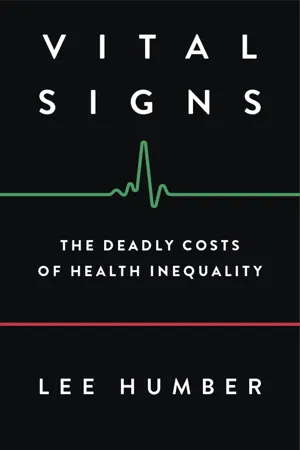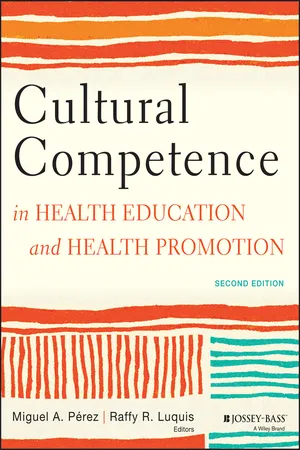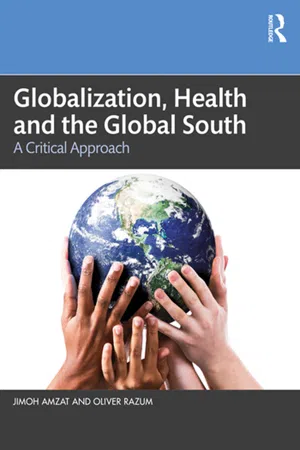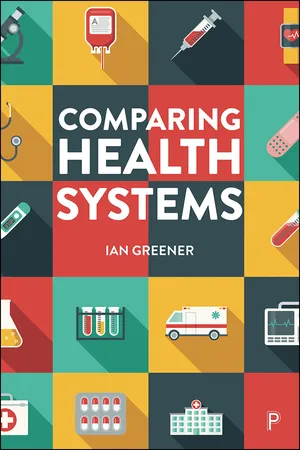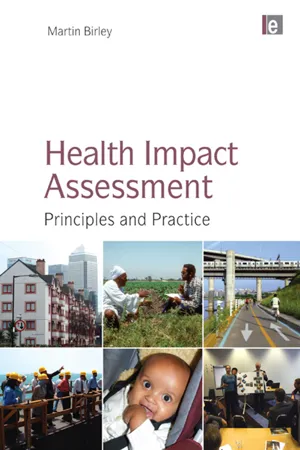Social Sciences
The Social Determinants of Health
The social determinants of health refer to the conditions in which people are born, grow, live, work, and age, and how these circumstances influence their health. These determinants include factors such as socioeconomic status, education, neighborhood and physical environment, employment, and social support networks. Understanding and addressing these social factors is crucial for promoting health equity and improving overall well-being.
Written by Perlego with AI-assistance
Related key terms
11 Key excerpts on "The Social Determinants of Health"
- eBook - ePub
Vital Signs
The Deadly Costs of Health Inequality
- Lee Humber(Author)
- 2019(Publication Date)
- Pluto Press(Publisher)
4The Social Determinants of Health
The Social Determinants of Health are a combination of social, economic and political factors that shape the health of individuals, communities and populations. These influences determine to a great extent people’s state of health or illness. The Social Determinants of Health are overwhelmingly shaped by policy and political ideologies. The WHO says, ‘This unequal distribution of health-damaging experiences is not in any sense a “natural” phenomenon but is the result of a toxic combination of poor social policies, unfair economic arrangements and bad politics.’1With regard to acting upon these determinants, two areas of action in particular were recommended by the WHO Commission on The Social Determinants of Health in their 2008 report, Closing the Gap in a Generation . The first area that needs addressing is daily living conditions, including healthy physical environments, fair employment and decent work, social protection across the lifespan and access to healthcare. The second major area concerns the distribution of power, money and resources, including equity in health programmes, public financing of action on the social determinants and economic inequalities.2Following Closing the Gap , the 2011 World Conference on Social Determinants of Health brought together delegations from 125 member states and resulted in the Rio Political Declaration on Social Determinants of Health. This declaration involved an affirmation that health inequities are unacceptable, and noted that these inequities arise from the societal conditions in which people are born, grow, live, work and age, including early childhood development, education, economic status, employment and decent work, housing environment and effective prevention and treatment of health problems.3Closing the Gap - Miguel A. Pérez, Raffy R. Luquis(Authors)
- 2013(Publication Date)
- Jossey-Bass(Publisher)
The 1978 International Conference on Primary Health Care (Alma Ata Conference) called for an urgent and effective national and international action to develop and implement primary health care throughout the world, and particularly in developing countries, in a spirit of technical cooperation and in keeping with a new international economic order. The conference acknowledged disparities and urged member states to explore ways to address disparities in social determinants of health (Tejada de Rivero, 2003).Research and subsequent international health promotion conferences have helped us better understand The Social Determinants of Health. In fact, McGinnis, Williams-Russo, and Knickman (2002) concluded that “our genetic predispositions affect the health care we need, and our social circumstances affect the health we receive” (p. 83). These conclusions were emphasized by the WHO Commission on Social Determinants of Health, which in 2008 concluded that “health is not simply about individual behaviour or exposure to risk, but how the socially and economically structured way of life of a population shapes its health” (para. 1).The Social Determinants of Health include social, economic, and environmental conditions, which are shaped by the distribution of money, power, and resources at the global, national, and local levels (WHO, 2008). The research literature suggests that social determinants (see figure 3.1 ) predict the greatest proportion of health status variance among individuals worldwide.Figure 3.1 Determinants of HealthSource: Healthy People 2020 (2012).Most health disparities affect groups marginalized because of socioeconomic status, race/ethnicity, sexual orientation, gender, disability status, geographic location, or some combination of these factors. In general, individuals from these groups have poorer health and less access to the social determinants or conditions that support health, including healthy food, good housing, good education, safe neighborhoods, and freedom from racism and other forms of discrimination (Whitehead & Dahlgren, 2007). More specifically, in terms of sexual orientation, over thirty thousand individuals from the gay, lesbian, bisexual, and transgender group die each year because of tobacco-related disease (American Cancer Society, 2005). In addition, African American gay, bisexual, and other men who have sex with men (MSM) represented an estimated 72 percent (10,600) of new infections among all African American men and 36 percent of an estimated 29,800 new HIV infections among all MSM (CDC, 2013). Statistics on selected social determinants are presented in table 3.2- eBook - ePub
Creating Community Health
Interventions for Sustainable Healthcare
- Simon Lennane(Author)
- 2023(Publication Date)
- Routledge(Publisher)
Table 2.2 ). These could equally be called political determinants, as they are sensitive to policy decisions. Addressing collective risk factors requires interventions at a collective level.Table 2.2 Social determinants of healthSocioeconomic Employment, income, social status Education Healthy child development, literacy, vocational training/higher education, access to digital technology Health-related Nutrition, coping skills, access to services Social environment Support networks, discrimination, safety, equity Physical environment Housing, transport, safety, greenspace The most important hard health outcomes – illness, mortality and life expectancy, together with health status and healthcare costs – are all influenced by social determinants, in particular the effects of inequality. Quantifying the enormous impact of social determinants makes the importance of addressing these factors clear.Cardiovascular disease, which kills more than one in ten people in the UK, is a good example of the causes of the causes. Coronary heart disease is due to arterial damage from inflammation, which is aggravated by stress, deprivation, inequality and loneliness, meaning that social factors are strongly linked to outcomes. Some risk factors such as age, sex and family history are not modifiable. Others, such as inactivity, smoking, poor sugar control and high blood pressure are modifiable risk factors that can be addressed through a combination of individual and societal approaches. Diabetes and high blood pressure both double the risk of cardiovascular disease,11 but the impact of deprivation is greater; people from the most deprived quintile have a mortality rate nearly three times that of those in the least deprived.12 Cardiovascular mortality in people who are in contact with mental health services is even higher.13 Addressing these risk factors substantially reduces healthcare costs (Table 2.3 - eBook - ePub
Anti-Oppressive Counseling and Psychotherapy
Action for Personal and Social Change
- Jason D. Brown(Author)
- 2019(Publication Date)
- Routledge(Publisher)
Contemporary public health has its origins in the sanitary campaigns of the nineteenth century (Stone, 1979). This period of increasing urbanization and poverty co-occurred with the spread of disease (Richardson, 2017). Science found that a lack of hygiene caused and transmitted disease (Prüss-Üstün & Neira, 2016). Sanitation was necessary to improve conditions. Public health offered a scientific basis for social influence and political decisions regarding which problems were caused by which factors and how those would be addressed through social hygiene measures (Irwin & Scali, 2007). Community-based health programs began to develop in the 1960s and 1970s, in part in response to growing awareness that top-down medication approaches were not helping those who were the most in need (Shediac-Rizkallah & Bone, 1998).Social determinants of health offer a view of population-level forces associated with varied health outcomes. Shared factors (Rosenfield, 1985) underlying the creation of social determinants were that: social aspects of health were of fundamental importance, a welfare approach to development was necessary, the participation of communities in health decisions was necessary, universal coverage to increase equity was essential, and making connections between sectors was the way forward. In 1986, the First National Conference on Health Promotion was organized by the World Health Organization (Baum, 2016). From this event, the Ottawa Charter was drafted (Gagné & Lapalme, 2017). The Charter is an international agreement about the social causes of illness. The “fundamental drivers of these conditions include unequal distributions of power, money and resources” (Marmot & Bell, 2012, p. S7).According to the World Health Organization (2015), social determinants of health are “the conditions in which people are born, grow, work, live and age, and the wider set of forces and systems shaping the conditions of daily life”. According to the National Academies of Sciences, Engineering, and Medicine (2017), there are nine areas that have a major influence on health disparities. These areas include early childhood development, educational achievement, employment, occupation, food security, access to quality health care, affordable housing and income. Finally, the degrees of discrimination faced and social support held also determine health.Social determinants influence population and individual health in several ways (Barer, 2017). One prominent means is the transmission of resources that meet basic physical and social needs. For example, low income is associated with food insecurity and inadequate nutrition. Another prominent view is that the lack of met needs causes stress that is health-damaging. For example, housing vulnerability because of family poverty is a source of stress for parents. A third view is that the determinants affect choices and opportunities and also form barriers to positive changes in behavior, which accumulate negative effects over time (Whitehead, Judge, & Benzeval, 1995). For example, poor nutrition during the prenatal period, infancy and early childhood contribute to educational challenges, early leaving and low job prospects. - eBook - ePub
Globalization, Health and the Global South
A Critical Approach
- Jimoh Amzat, Oliver Razum(Authors)
- 2021(Publication Date)
- Routledge(Publisher)
3 Social and Global Determinants of Health
DOI: 10.4324/9781003247975-33.1 Introduction
Health is contextual in the sense that there are myriad factors that influence it. These factors are known as social determinants of health (SDH). Some of these factors even constitute the causes of diseases because they exact direct influence on the likelihood of developing a disease. It is in recognition of the SDH that the World Health Organization (WHO) instituted the WHO Commission of Social Determinants of Health (CSDH). It is essential to understand these contextual factors called SDH to understand population health in general. The SDH are the prime factors that, if improved, can possibly improve population health outcomes. Many countries of the Global South (especially sub-Saharan Africa [SSA]) are still confronted with traditional risks of infectious diseases, largely as a result of living conditions related to poverty and inadequate infrastructures, such as water and power supplies. In SSA, such inadequate infrastructure becomes a significant determinant of health. There are several communities without potable water, which explains the risk of guinea worm and other water-borne diseases. It is in this light that SDH is sometimes regarded as the fundamental causes of diseases.Specifically, SDH refers to the social circumstances and conditions in which people are born, grow, live, work and play that invariably account for human health (CSDH, 2008). The social conditions even determine if a child will be born alive and for how long that child will likely live. Child mortality has been closely linked to social circumstances. It starts with maternal dietary behavior; whether or not the pregnant woman has access to adequate food required to sustain good health and development for both the fetus and herself. In some poor regions, famine and/or poor nutrition are common, impacting both the mother and unborn child. Inadequate access to healthcare also promotes home delivery in SSA, which also accounts for the high rate of maternal mortality and stillbirth. During delivery, many women do not have the opportunity to have skilled attendants. The issues of dietary behavior and access to a skilled attendant at birth constitute circumstances that can influence health outcomes. The focus on SDH in improving population health is receiving considerable attention across the world, both at a global level and within-country action (Donkin et al., 2017). - eBook - ePub
- John J Macdonald, University of Western Sydney, Australia(Authors)
- 2012(Publication Date)
- Routledge(Publisher)
social determinants of health give substance to this common-sense view by providing us with empirical evidence of this impact.The work on The Social Determinants of Health has often emerged from considerations about differentials in health status: concerns as to why some people and groups of people have poorer health outcomes than others. At the same time there has been an increase in our collective knowledge of links between the body’s physiology and the working of the mind. Often the brain mediates this link between the body and its environment either directly as the person encounters thoughts, ideas, non-material phenomena and reacts to these; or indirectly, as the mind interprets the physical phenomena it encounters – like cold, heat, smoke, physical deprivation like hunger, etc.The evidence grows of the links between the social context and the individual’s biological and mental condition, their health and well-being:There is a chain that runs from the behaviour of cells and molecules to the health of populations, and back again, a chain in which the past and the present social environments of individuals and their perceptions of those environments constitute a key set of links. No one would pretend that the chain is fully understood, or is likely to be for a considerable period of time to come. But the research evidence currently available no longer permits anyone to deny its existence.Evans et al (1994), p184 Context is more than just a contributory factorIt is under the banner of The Social Determinants of Health that researchers have collected information about these ‘key links’ between social circumstances and the health of populations and, of course, of the individuals making up these populations. When we speak of The Social Determinants of Health, we are looking at the factors in the social context of people’s lives which contribute to and are an essential dimension - eBook - ePub
- Ian Greener(Author)
- 2021(Publication Date)
- Policy Press(Publisher)
At the same time, there are a range of factors which are likely to affect our health, but which generally fall outside of the control or remit of most health services. These factors are often referred to as the ‘social determinants’ of health, and go from those that might come most quickly to mind, such as the levels of smoking and drinking, and other activities we have come to associate with poor health outcomes, as well as education levels and the quality of housing available. However, there may also be much larger social factors, such as levels of inequality, which those taking a more large-scale, social determinants approach suggest are extremely important.Large-scale social determinants such as inequality or poverty are especially important because they intersect across a range of factors to produce systematic effects: the poorest people tend to smoke more than those with higher incomes, may have access to only lower-quality housing and are likely to have successfully completed less education (Mullainathan and Shafir, 2013 ). The Social Determinants of Health can be separated analytically, but are likely to cluster and combine in particular ways so that poor health outcomes especially are linked to a combination of different factors. This intersectionality seems to be especially the case for people in some minority groupings (Ragin and Fiss, 2016 ) to the extent that some writers have come close to claiming that racial differences underlie differences in societal outcomes (Hernstein and Murray, 1996 - eBook - ePub
Shaping Nursing Healthcare Policy
A View from the Inside
- Diane Seibert, Beverly Malone, Patrick DeLeon(Authors)
- 2022(Publication Date)
- Academic Press(Publisher)
Dahlgren & Whitehead, 2021 ).The WHO conceptual social determinant of health framework
The WHO SDOH Framework depicts how social, economic, and political factors such as income, education, occupation, gender, race, and ethnicity impact a person's socioeconomic position which then plays a role in determining health outcomes (Solar & Irwin, 2010 ). These factors can influence a person's ability to lead a healthy life, impacting things such as quality of housing, opportunities in the built environment that encourage physical activity, and access to healthcare services (National Academies of Sciences, Engineering, and Medicine, 2021 ; Solar & Irwin, 2010 ). In this framework, SDH are categorized into two broad types that work together to impact health and well-being. These determinants are structural determinants, which include socioeconomic and political contexts, class, gender, ethnicity and racism, and intermediary determinants, which include the living and working conditions of people (Solar & Irwin, 2010 ).The Social Determinants of Health and social needs model of Castrucci and Auerbach
The Social Determinants of Health and Social Needs Model of Castrucci and Auerbach (2019) elucidates upstream, midstream and downstream strategies to address SDH (Castrucci & Auerbach, 2019 ). The downstream strategies are individual-level interventions that include disease treatent and chronic disease management. The midstream strategies address social needs including housing conditions, employment, and food security (Castrucci & Auerbach, 2019 ). While downstream and midstream strategies impact individuals, upstream stretegies impact communities (Castrucci & Auerbach, 2019 ; National Academies of Sciences, Engineering, and Medicine, 2021 ). Upstream interventions influence root causes or sociostructural factors such as policies, economics, discrimination, and racism (Castrucci & Auerbach, 2019 ; National Academies of Sciences, Engineering, and Medicine, 2021 - eBook - ePub
Health Impact Assessment
Principles and Practice
- Martin Birley(Author)
- 2013(Publication Date)
- Routledge(Publisher)
In England, evidence-based checklists and mental well-being impact assessment tools have been developed to assist with commissioning, delivering or developing proposals (National Mental Health Development Unit, 2010). This sub-field of HIA is very active.2.4 DETERMINANTS OF HEALTHHealth determinants are factors that influence our state of health. The factors are personal, social, cultural, economic and environmental. They include our physical environment, income, employment, education, social support and housing. They act in unison and are synergistic. The italicized words in the box are examples of health determinants.Examples of health determinantsWe get malaria because our immunity is low, we do not have access to or are not taking the right drug, there is an infected mosquito, and the mosquito bites us. The infected mosquito is necessary but not sufficient.Asthmatic attacks do not only depend on the presence of a pollutant but also on the age and immune status of the individual and the medical care provided.There are a number of different models and diagrams that are used to illustrate this concept. One of the most well-known is the lifeworld diagram of Dahlgren and Whitehead (1991), or its alternative representation (Barton et al, 2003). These diagrams envisage five successive spheres of influence starting with the individual and then ranging through social and community influences, living and working conditions, and general socio-economic cultural and environmental conditions.In this book, three principal categories of health determinants are used: 1 individual/family determinants such as education, immune status and age; 2 physical and social environment determinants such as exposure to pollutants and employment opportunities; 3 institutional determinants such as medical care and clean water provision.Within each category, there are a number of subcategories, illustrated in Table 2.6 - eBook - ePub
A Biopsychosocial Approach to Health
From Cell to Society
- Rachel C. Sumner(Author)
- 2023(Publication Date)
- SAGE Publications Ltd(Publisher)
9 The Social Determinants of Public HealthIntroduction
This chapter is going to use some of the knowledge from the last chapter, but look at specific case studies from public policy to understand top-down health influence. In the last chapter, the example of the Marmot review of 2010 was given to introduce the concept of the social gradient to health on the population level. Social issues are key drivers of health inequalities, and many social issues are not purely interpersonal from the sense of communities and groups; many can be the subject of policies and leadership. This chapter is going to look specifically at areas of public policy and how they have an impact on public health, and where social inequalities in these areas may exist. I have chosen three case studies that align to the UN Sustainable Development Goals: transport (SDG12: Responsible consumption and production); education (SDG4: Quality education); and housing (SDG11: Sustainable cities and communities), but it is worth noting that all of these case studies also touch on other goals (particularly SDG9: Industry, innovation, and infrastructure; and SDG10: Reduced inequalities). The examples used in this chapter are centred on the UK because this is the nation with which I am most familiar, but also (as in Chapters 3 and 8), it is a country of curious parallels, being both a global financial superpower (although this status is now arguably changing) and a nation of increasing inequality. The combined knowledge from this chapter and the last will provide you with an integrated overview of the complex interplay between person-level and system-level factors in health. We will look at the case studies to illustrate the impact of public health policy on populations, individuals, and cellular-level health. Each case study discusses why that policy is a public health issue (even though each policy being focused on is not explicitly about health), including the impact on people and groups, how this particular area can help or harm health, social factors associated with each component, and how public policy then impacts health outcomes. It is also useful to consider how some of the topics that were discussed in Chapter 3, particularly the elements introduced in the section on social exclusion, will be relevant to each of these policy case studies. In this way, you should be able to get an appreciation of the institutional level of social exclusion that exists in societies, and of how this filters down to people and groups of peoples to impact their health. Each section also closes with specific notes on policy and the various factors that may influence and be influenced by policy. - eBook - ePub
Health Systems Science Review
Health Systems Science Review E-Book
- Jesse M. Ehrenfeld, Jed D. Gonzalo(Authors)
- 2019(Publication Date)
- Elsevier(Publisher)
Fig. 4.1 . Mrs. Gurung is likely affected by multiple social determinants of health that are impacting the receipt of high-quality care. She may not have health insurance, financial resources, or access to transportation. Additionally, language barriers and other factors may also be contributing to her failure to follow up. A careful social history and a culturally sensitive approach may help mitigate some of these factors, to ensure improved patient care.Fig. 4.1 Social determinants of health.Source: (From Henry J Kaiser Family Foundation. https://www.kff.org/disparities-policy/issue-brief/beyond-health-care-the-role-of-social-determinants-in-promoting-health-and-health-equity. Published November 4, 2015.)Case 2 answers
Q 2.1: d. Utilization of a professional Nepali interpreter during the delivery- Well-established data suggest that minority groups have higher rates of chronic diseases. Multiple factors likely contribute to this disparity. Cultural competency is defined as “a set of congruent behaviors, attitudes, and policies that come together in a system, agency, or amongst professionals, and enables that system, agency, or those professionals to work effectively in cross-cultural situations.” Another definition of cultural competency is “the acknowledgement and incorporation—at all levels—of the importance of culture, assessment of cross-cultural relations, vigilance toward dynamics that result from cultural differences, expansion of cultural knowledge, and adaptation of services to meet culturally unique needs.”
- Additionally, more than 8% of Americans report limited English proficiency. Unfortunately, access to medical interpretation in health care delivery systems is not uniform or common. Furthermore, the majority of US teaching hospitals do not provide training in the use of medical interpreters. This significantly impacts patients as language barriers are linked to decreased patient satisfaction. In contrast, in one study, the use of professional interpreters, instead of ad hoc interpreters, resulted in increased patient comprehension, improved clinical outcomes, and improved patient satisfaction. Though both providers and interpreters rate in-person interpretation more highly than other modalities, patient satisfaction is unchanged between in-person, video, and telephonic interpretation.
Index pages curate the most relevant extracts from our library of academic textbooks. They’ve been created using an in-house natural language model (NLM), each adding context and meaning to key research topics.
